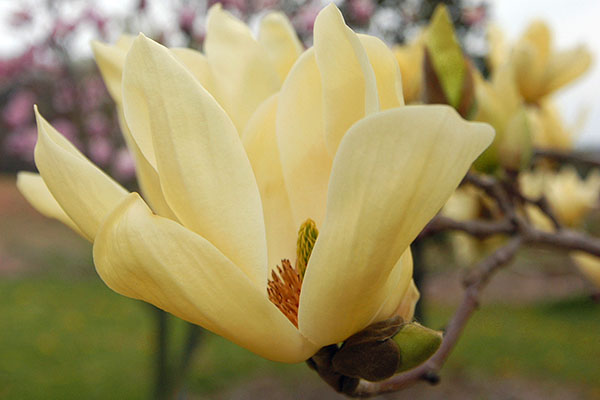Magnolia acuminata
Cucumbertree Magnolia
New York down to Flordia west to Illinois.
Pyramidal in youth; rounded with spreading branches at maturity.
Moist soil in rich woods and full sun. This tree does not do well with saturated or dry soils.
Magnolia acuminata, or Cucumber tree, is a handsome tree with a rounded, outline and massive wide-spreading branches at maturity. Young bark is relatively smooth gray, changing to ridged and furrowed with flat gray ridges and relatively narrow vertical fissures. Leaves are alternate, simple, and dark green. Buds have silky, pale green hairs. Flowers are yellowish green, slightly fragrant, and not particularly showy. Fruits are an aggregate of follicles, pinkish red, emerging in October. They look like a small cucumber, hence the common name. Excellent tree for large lawn areas, golf courses or naturalized areas. Great character tree, especially when mature.
Dark green in summer. Alternate, simple and elliptical to ovate, short acuminate apex, often wavy.
Buds are valvate, very pubescent, single keeled scale.
Ridged and furrowed, often scaley, peeley bark in adulthood. Gray-brown in color.
greenish yellow
Pinkish-red follicles in October. Flowers open in May-June and are large, greenish-yellow and are slightly fragrant.
Seed.
'Butterflies' Deeper yellow flowers.
'Elizabeth' - Cross of M. acuminata and M. denudata (xbrooklynensis) with pale yellow flowers.
'Ellen' - Yellow variegated leaves.
'Goldfinch' - Pale yellow flowers.
'Goldstar' - Pale yellow, five-pointed flowers.
'Ivory Chalice' - Mature tepals are ivory.
'Large Yellow' - Large flowers.
'Sundance' - Large yellow flowers.
'Yellow Lantern' - Pale yellow, cup-shaped flowers.






